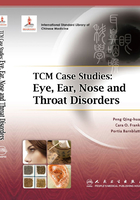
上QQ阅读APP看书,第一时间看更新
CASE SCENARIO
The following cases present variations of this condition. After familiarizing yourself with the possible common patern presentations and appropriate formulas for treatment, use the following exercises to test your overall understanding of the condition.
1. Female, age 12. The patient presented with ptosis in both eyes, which was better in the morning and becoming worse in the late afternoon. Other signs and symptoms included fatigue, a pale tongue body with a thin white coating, and a thin pulse.
Select the most appropriate therapeutic principles:
A. Consolidate the kidney, fortify the spleen, invigorate blood and unblock the collaterals.
B. Supplement the liver and kidney, eliminate wind and unblock the collaterals.
C. Dissolve phlegm, eliminate wind and unblock the collaterals.
D. Raise yang, beneft qi, invigorate blood and unblock the collaterals.
E. Smooth the liver, resolve constraint, invigorate blood and unblock the collaterals.
2. Male, age 17. The patient presented with ptosis in both eyes, which was beter in the morning and becoming worse in the late afernoon. The patient was fatigued. The tongue body was pale with a thin white coating. The pulse was thin.
Select the most appropriate formula:
A. Modified Yòu Guī Wán (Right-Restoring Pill)
B. Modified Liù Wèi Dì Huáng Wán (Six-Ingredient Rehmannia Pill)
C. Modified Zhèng Róng Tāng (Face-Righting Decoction)
D. Modified Dān Zhī Xiāo Yáo Săn (Moutan and Gardenia Free Wanderer Powder)
E. Modified Bŭ Zhōng Yì Qì Tāng (Center-Supplementing and Qi-Boosting Decoction)
3. Male, age 56. The patient presented with sudden ptosis in his right eye with impaired eyeball movement and double vision. He had a pale tongue with a white greasy coating and a slippery pulse.
Select the most appropriate formula:
A. Modified Yòu Guī Wán (Right-Restoring Pill)
B. Modified Liù Wèi Dì Huáng Wán (Six-Ingredient Rehmannia Pill)
C. Modified Zhèng Róng Tāng (Face-Righting Decoction)
D. Modified Dān Zhī Xiāo Yáo Săn (Moutan and Gardenia Free Wanderer Powder)
E. Modified Bŭ Zhōng Yì Qì Tāng (Center-Supplementing and Qi-Boosting Decoction)
Answers
1. D
2. E
3. C
Additional Commentary
The first case scenario’s patient exhibits clear signs of spleen qi deficiency and sinking. Therefore, the treatment principle in this case is to raise yang, benefit qi, invigorate blood and unblock the collaterals.
The patient in the second case scenario also presents with a pattern of sinking of spleen qi and failure to ascend, which results in ptosis. The formula that treats this pattern is modified Bŭ Zhōng Yì Qì Tāng (Center-Supplementing and Qi-Boosting Decoction). Because the modifications are not known, a helpful discussion can be found in The English-Chinese Encyclopedia of Practical Traditional Chinese Medicine. 3 A summary of the modifications follows:
● To the general formula, add gé gēn (Radix Puerariae Lobatae) and bái sháo (Radix Paeoniae Alba).
● If there also is blood deficiency, then add jī xuè téng (Caulis Spatholobi) and héshŏu wū (Radix Polygoni Multiflori).
● If the ptosis is severe, add chuān xiōng (Rhizoma Chuanxiong), dān shēn (Radix et Rhizoma Salviae Miltiorrhizae) and sī guā luò (Retinervus Luffae Fructus). Also, be sure to use rén shēn (Radix et Rhizoma Ginseng) instead of dăng shēn (Radix Codonopsis). This last group is especially compelling, as it modifies the formula with medicinals that invigorate the blood, dispel wind and clear the collaterals.
● If there are loose stools, add gān jiāng (Rhizoma Zingiberis) and zhì fù zĭ (Radix Aconiti Lateralis Praeparata). This modification warms the spleen yang and it references Fù Zĭ Lĭ Zhōng Wán (Aconite Center-Regulating Pill).
● If there is a fatigue and sticky feeling in the mouth, add pèi lán (Herba Eupatorii), cāng zhú (Rhizoma Atractylodis) and shā rén (Fructus Amomi) to transform dampness and harmonize the stomach.
Research confirming the efficacy of this formula to treat ptosis due to sinking of spleen qi and failure to ascend was detailed in a research paper outlining the integrative treatment with Bŭ Zhōng Yì Qì Tāng and oral prednisone to treat 27 cases of myasthenia gravis ptosis. After six months, the overall success rate was an impressive 81.5% cure rate. 4
In the final case scenario’s patient exhibits clear signs of wind phlegm blocking the collaterals, thus modified Zhèng Róng Tāng (Face-Righting Decoction) is recommended.